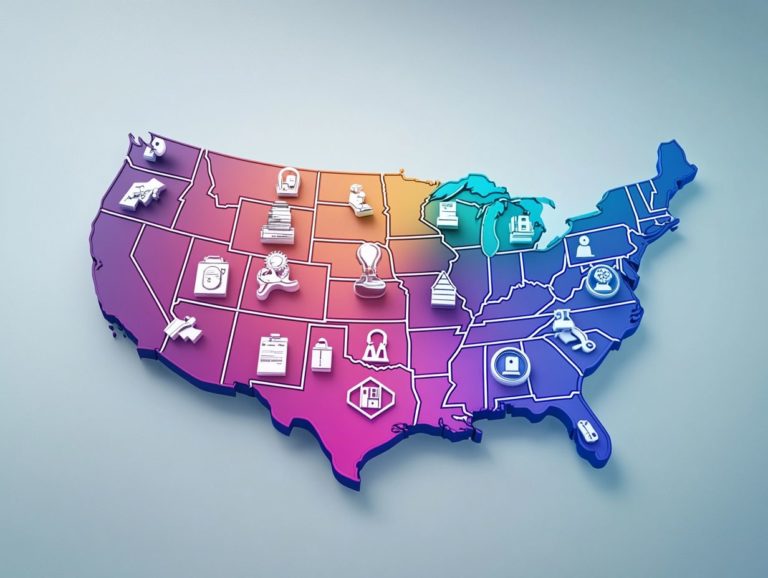How to Combat High-Risk Driver Stigma
Being labeled a high-risk driver carries significant weight, often leading to negative perceptions that can permeate various aspects of your life. This discussion delves into the stigma surrounding high-risk driving, illuminating the behaviors and factors that contribute to this classification. It examines the legal and financial repercussions that follow and practical steps you can take to combat the stigma and enhance your driving habits.
This discussion also highlights organizations and resources available to assist you in reshaping your driving reputation. Get ready to explore and tackle the challenges ahead!
Contents
- Key Takeaways:
- The Stigma of Being a High-Risk Driver
- Causes of High-Risk Driving
- Consequences of High-Risk Driving
- Overcoming the Stigma
- Support and Resources for Drivers with Higher Risks
- Frequently Asked Questions
- 1. What is high-risk driver stigma and how does it affect me?
- 2. How can I combat high-risk driver stigma?
- 3. Will my insurance rates be affected by high-risk driver stigma?
- 4. Are there any resources or programs available to help combat high-risk driver stigma?
- 5. Can I do anything to prevent being labeled as a high-risk driver?
- 6. How can I educate others and promote change in the perception of high-risk drivers?
Key Takeaways:

Here are the essential points to remember about high-risk driving:
- High-risk drivers face negative stigma due to their driving behaviors, which can lead to legal and financial consequences.
- Common factors that contribute to high-risk driving include distracted driving, aggressive behavior, and substance abuse.
- To combat stigma, high-risk drivers can take steps to improve their driving habits and reputation and seek support from organizations and programs designed for assistance.
The Stigma of Being a High-Risk Driver
The stigma attached to being classified as a high-risk driver can greatly impact you. This often results in soaring insurance premiums and a tarnished reputation among peers, employers, and even within your own self-perception.
Despite many high-risk drivers demonstrating commendable driving habits in various situations, they are often unfairly branded as reckless. It’s crucial to address this stigma now to avoid long-term consequences! Recognizing this stigma is essential, as it can obstruct effective risk management strategies and limit access to crucial resources for improvement, including what to do if you’re classified as a high-risk driver, coaching methods, and safety measures in the transportation industry.
Understanding the Negative Perception
The negative perception surrounding high-risk drivers often arises from a lack of understanding about their true driving behaviors and the circumstances they navigate. These circumstances may involve pressures like tight deadlines and equipment challenges that can lead to incidents.
Many overlook the complex realities these drivers encounter daily, falling victim to misconceptions shaped by isolated incidents or sensational media portrayals. This bias against high-risk drivers can be harmful, impacting not only their careers but also the industry as a whole.
Implementing safety training programs focused on driver improvement can significantly influence these perceptions. By educating both drivers and the public about the challenges high-risk drivers face, awareness programs can effectively showcase responsible driving behaviors and highlight successful interventions that have reduced risks.
This comprehensive approach dismantles harmful stereotypes and underscores a commitment to safety and professional growth.
Causes of High-Risk Driving
High-risk driving stems from a myriad of causes, ranging from behavioral patterns and external pressures to insufficient training and resources for effective risk management. Elements like operational demands, fatigue, and poor driving habits significantly escalate the risks associated with fleet operations.
- Behavioral patterns
- External pressures such as tight schedules
- Insufficient training for drivers
- Operational demands that create stress
By identifying these risk factors, you can develop customized coaching programs that target specific driver challenges, ultimately enhancing your safety management practices.
Common Factors and Behaviors

Common factors that contribute to high-risk driving often include poor driving habits, equipment issues, and a lack of thorough risk checks that consistently monitor driver behavior.
These behaviors can reveal themselves in various ways, such as frequent speeding, aggressive lane changes, or distractions from mobile devices. All of these significantly elevate the risk of accidents.
External factors like road conditions, weather variability, and the time of day can further worsen these risky behaviors. For example, navigating slick roads during heavy rain can lead to poor reactions in changing traffic, increasing the likelihood of safety violations.
The implementation of effective monitoring systems, such as in-vehicle cameras and real-time feedback mechanisms, is crucial for identifying these behaviors early on. This proactive approach allows for targeted interventions that can significantly enhance overall safety on the road.
Consequences of High-Risk Driving
High-risk driving carries significant legal and financial repercussions that can impact both you as a driver and your fleet operations. You may face increased liability and insurance costs, along with potential legal consequences stemming from safety violations.
This situation places you at a disadvantage and threatens the reputation of your fleet management organization. Effective risk management strategies like checking to ensure rules are followed and crash prevention initiatives are crucial for mitigating these risks and safeguarding your interests.
Legal and Financial Implications
The legal implications of high-risk driving are far-reaching. They encompass increased fines, points on your driving record, and the potential loss of your license. Financially, you may face higher insurance premiums and greater liability costs.
These challenges create a complex web for both individuals and organizations. Each infraction affects your immediate standing and significantly influences your organization s overall risk and liability profile.
The history of accidents becomes a crucial metric for insurers when assessing coverage costs and policy availability. Therefore, businesses must prioritize effective risk assessment strategies now to protect their futures! Understanding these legal and financial ramifications is essential for anyone navigating this high-stakes landscape.
Overcoming the Stigma
Overcoming the stigma of being labeled a high-risk driver demands a strategic, multifaceted approach. It involves enhancing your driving habits, employing effective coaching strategies, and developing comprehensive safety improvement programs tailored specifically to your individual needs.
Each element plays a crucial role in reshaping perceptions and fostering a safer driving experience.
Steps to Improve Driving Habits and Reputation

Improving your driving habits and reputation requires a proactive mindset. Engage in ongoing safety training, embrace a coaching style that values human connection, and establish effective feedback mechanisms.
These strategies promote accountability among drivers and cultivate a culture of continuous improvement. Regular safety workshops refresh your understanding of best practices while allowing you to learn from real-life scenarios shared by your peers.
Adopting a coaching approach enables you to pinpoint specific challenges and collaborate on solutions. Integrating feedback mechanisms like performance metrics and peer evaluations provides you valuable insights into your driving behavior.
This awareness highlights areas for improvement and reinforces positive habits. This comprehensive approach ensures that you are not merely compliant but genuinely committed to honing your skills.
Support and Resources for Drivers with Higher Risks
Drivers with higher risks can take advantage of an array of support and resources specifically tailored to enhance their skills and safety profiles. This includes access to organizations committed to delivering important training programs and educational materials that enable them to drive more safely and confidently.
Organizations and Programs for Assistance
Numerous organizations and programs are available to assist drivers with higher risks, providing essential resources for safety training and coaching you to adopt better habits.
These initiatives aim not only to enhance your individual driving skills but also to foster a broader culture of road safety. For instance, organizations like the National Highway Traffic Safety Administration (NHTSA) focus on educating drivers about the perils of distractions and impaired driving. They offer valuable online guides and community workshops tailored to your needs.
Local programs also provide behind-the-wheel assessments, which are practical driving tests to evaluate your skills, and counseling services. These resources equip you with the tools necessary to make informed decisions on the road. By cultivating awareness and promoting responsible behaviors, these programs play a pivotal role in reducing accidents and enhancing overall traffic safety.
Frequently Asked Questions
1. What is high-risk driver stigma and how does it affect me?
High-risk driver stigma refers to the negative perception and labeling of individuals considered to be at a higher risk for causing accidents or receiving traffic violations. This stigma can lead to discrimination and higher insurance rates for these individuals.
2. How can I combat high-risk driver stigma?
One way to combat high-risk driver stigma is by practicing safe driving habits and obeying traffic laws. For more guidance, check out these tips for staying safe as a high-risk driver. By being a responsible and cautious driver, you can prove that you are not a high-risk driver and help to break the stigma.
3. Will my insurance rates be affected by high-risk driver stigma?
Unfortunately, high-risk driver stigma can result in higher insurance rates for individuals labeled as such. Insurance companies may view these individuals as a higher risk and charge them more for coverage.
4. Are there any resources or programs available to help combat high-risk driver stigma?
Yes, resources and programs are available to help combat high-risk driver stigma. Some insurance companies offer defensive driving courses for drivers with higher risks, which can help improve their driving skills and potentially lower their rates.
5. Can I do anything to prevent being labeled as a high-risk driver?
Yes, you can take steps to prevent being labeled as a high-risk driver. This includes maintaining a clean driving record, avoiding risky behaviors while driving, and following all traffic laws.
6. How can I educate others and promote change in the perception of high-risk drivers?
You can educate others and promote change by being a positive example on the road and spreading awareness about high-risk driver stigma. You can also advocate for fair insurance rates and support organizations that work towards combating this stigma.







